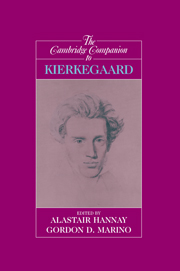Book contents
- Frontmatter
- Introduction
- 1 Out with It!
- 2 The unknown Kierkegaard
- 3 Art in an age of reflection
- 4 Kierkegaard and Hegel
- 5 Neither either nor or
- 6 Realism and antirealism in Kierkegaard's Concluding Unscientific Postscript
- 7 Existence, emotion, and virtue
- 8 Faith and the Kierkegaardian leap
- 9 Arminian edification
- 10 “Developing” Fear and Trembling
- 11 Repetition
- 12 Anxiety in The Concept of Anxiety
- 13 Kierkegaard and the variety of despair
- 14 Kierkegaard's Christian ethics
- 15 Religious dialectics and Christology
- 16 The utilitarian self and the "useless" passion of faith
- Bibliography
- Index
8 - Faith and the Kierkegaardian leap
Published online by Cambridge University Press: 28 May 2006
- Frontmatter
- Introduction
- 1 Out with It!
- 2 The unknown Kierkegaard
- 3 Art in an age of reflection
- 4 Kierkegaard and Hegel
- 5 Neither either nor or
- 6 Realism and antirealism in Kierkegaard's Concluding Unscientific Postscript
- 7 Existence, emotion, and virtue
- 8 Faith and the Kierkegaardian leap
- 9 Arminian edification
- 10 “Developing” Fear and Trembling
- 11 Repetition
- 12 Anxiety in The Concept of Anxiety
- 13 Kierkegaard and the variety of despair
- 14 Kierkegaard's Christian ethics
- 15 Religious dialectics and Christology
- 16 The utilitarian self and the "useless" passion of faith
- Bibliography
- Index
Summary
In a journal entry from 1842-3 Kierkegaard asks rhetorically, “Can there be a transition from quantitative qualification to a qualitative one without a leap? And does not the whole of life rest in that” (JP I 110)? He thus strikingly and unambiguously sets the leap in perspective - the leap, the form of qualitative transformation, lies at the heart of all life. Later in his journals this master of polemic against the theoretical makes two intriguing references to what he calls “my theory of the leap” (JP III 20). Whether or not he has a theory as such, the concept of a leap is appropriately associated with the name of Kierkegaard, since the leap is a structural element that winds its way throughout his whole authorship: it informs his various accounts of the peculiar character of transitions between radically different ways of life as well as his challenge to the philosophical and romantic accounts of such transitions that were influential in his day.
The popular association of the leap with Kierkegaard is often couched in terms of the leap of faith. It is worthwhile to be reminded, however, and interesting to note, that Kierkegaard never uses any Danish equivalent of the English phrase “leap of faith,” a phrase that involves a circularity insofar as it seems to imply that the leap is made by faith. He does, however, clearly and often refer to the concept of a leap (Spring) and to the concept of a transition (Overgang) that is qualitative (qvalitativ) or, alternatively, a meta-basis eis all0 genos (transition from one genus to another); moreover, he clearly and often refers to such a qualitative transition to religiousness and to faith in an eminent sense, namely, Christian religiousness.
- Type
- Chapter
- Information
- The Cambridge Companion to Kierkegaard , pp. 207 - 234Publisher: Cambridge University PressPrint publication year: 1997
- 11
- Cited by



